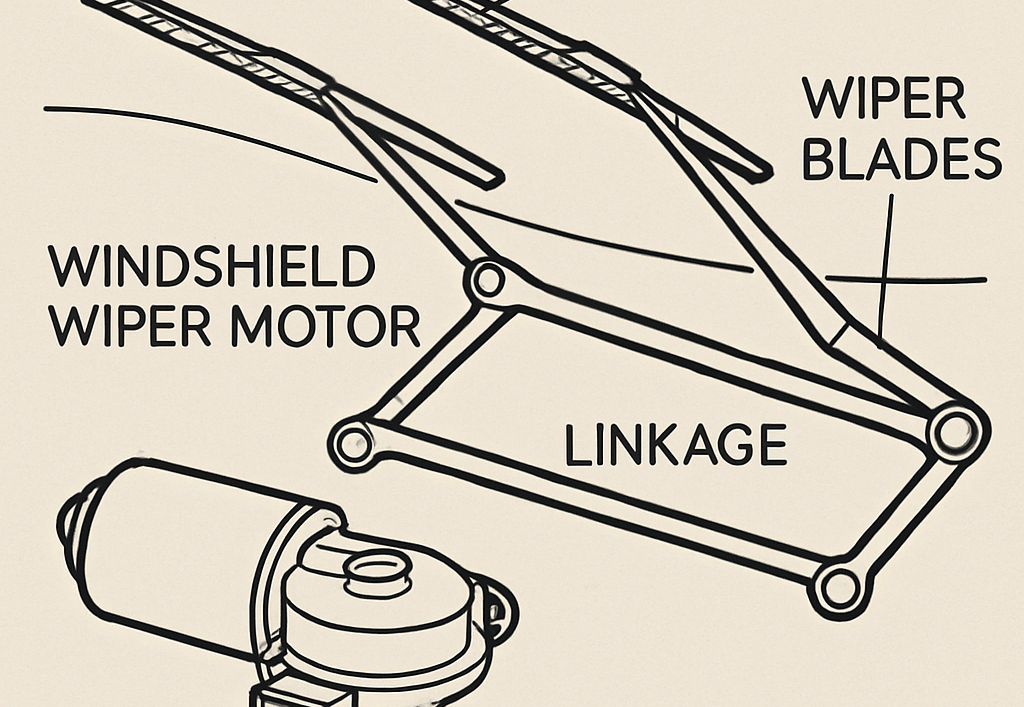Windshield Wiper Motor Guide: Function & Replacement
Explore the functionality of the windshield wiper motor, its key components, and signs you need a replacement. Keep your wiper system in top shape for safer driving.
LEILI
Hower Yang
8/14/20253 min read


Understanding Windshield Wiper Motor Functionality
# Understanding Windshield Wiper Motor Functionality
When you're driving in a downpour, few things are more critical for your safety than a clear view of the road. Your windshield wipers are essential for maintaining visibility, and at the heart of this system is the windshield wiper motor. In this article, we'll dive into how windshield wiper motors work, their components, and how to identify when you need a replacement.
The windshield wiper motor is an electric motor that powers the movement of your vehicle’s wipers. This motor is responsible for converting electrical energy into mechanical energy, which moves the wiper blades back and forth across your windshield. Without a functioning motor, your wipers would be ineffective, leaving you with a potentially dangerous driving situation.
Key Components of a Windshield Wiper Motor
Understanding the different parts of the windshield wiper motor can help you identify issues and perform basic maintenance or replacement if necessary. Here are the main components:
Electric Motor: This is the main component that converts electrical energy from your car's battery into mechanical energy.
Linkage or Transmission: This connects the motor to the wiper arms and converts the rotational motion of the motor into the sweeping motion of the wipers.
Crank Arm: Attached to the motor shaft, it is responsible for the back-and-forth motion.
Gearbox: It houses the gears that reduce the speed of the motor's rotation, allowing for the correct speed and torque to move the wipers.
How It Works
When you activate the wipers, either manually or via an automatic sensor, an electrical signal is sent to the wiper motor. The motor then begins to rotate, and this rotation is translated into the familiar back-and-forth motion of the wipers through the linkage system. The gearbox ensures that the wipers move at a speed appropriate for the current weather conditions.
Signs You Need a Windshield Wiper Motor Replacement
Like any other car part, the windshield wiper motor can wear out over time. Here are some signs that you might need to consider a replacement:
Slow or Non-Functioning Wipers
One of the most common signs of a failing wiper motor is wipers that move slower than usual or stop working altogether. If you notice a significant decrease in speed, it might be time to check the motor.
Unusual Noises
Grinding, whining, or any unusual sounds coming from the wiper area could indicate a problem with the motor or its components. These noises often suggest worn-out gears or a failing motor.
Wiper Blades Stopping Mid-Wipe
If your wipers stop in the middle of their cycle and refuse to return to their resting position, the motor might be failing. This can often be due to an internal fault within the motor or a problem with the linkage.
Windshield Wiper Motor Replacement Guide
If you've determined that the motor is the issue, you might be able to replace it yourself, depending on your comfort level with car maintenance. Here's a simplified guide to help you out:
Tools You'll Need
Screwdrivers (flathead and Phillips)
Socket set
Replacement motor
Wrench
Steps to Replace the Motor
Disconnect the Battery: Safety first! Always disconnect the battery before working on electrical components.
Remove the Wiper Arms: Use a wrench to remove the nuts holding the wiper arms in place and gently lift them off.
Access the Motor: Remove the panel or cover that conceals the wiper motor. This may require a screwdriver or socket set.
Disconnect the Motor: Unplug the electrical connector and remove any mounting bolts holding the motor in place.
Install the New Motor: Place the new motor in position, secure it with the mounting bolts, and reconnect the electrical connector.
Reattach the Wiper Arms: Secure the wiper arms back in place and ensure they are correctly aligned.
Test the Wipers: Reconnect the battery and test the wipers to ensure everything is working smoothly.
Professional Assistance
If you're unsure about performing the replacement yourself, it's always best to consult a professional mechanic. They can ensure the job is done correctly and safely.
Maintaining Your Windshield Wiper System
Regular maintenance of your windshield wiper system can extend the life of your wiper motor and ensure your wipers function effectively:
Regular Inspections
Check your wipers regularly for wear and tear. Look for cracks, splits, or any signs of damage on the blades and replace them if necessary.
Keep It Clean
Dirt and debris can cause additional wear on your wiper blades and motor. Clean your windshield and wiper blades regularly to prevent buildup.
Use the Right Wiper Fluid
Ensure you're using a high-quality wiper fluid that's appropriate for your climate. This helps keep your windshield clear and reduces strain on the wiper motor.
Conclusion
The windshield wiper motor is a vital component of your vehicle's safety system. Understanding its functionality and knowing the signs of potential issues can help you maintain visibility on the road and prevent unexpected failures. Whether you're a DIY enthusiast or prefer professional assistance, ensuring your wiper system is in good working order is crucial for safe driving.
By following these guidelines and keeping an eye on your wiper system, you'll be well-equipped to handle any weather conditions that come your way.
